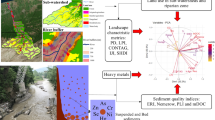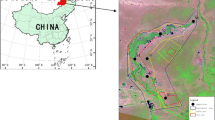Abstract
Phosphorus (P) flux potential can predict the trend of phosphorus release from wetland sediments to water and provide scientific parameters for further monitoring and management for phosphorus flux from wetland sediments to overlying water. Many studies have focused on factors affecting sediment P flux potential in sediment-water interface, but rarely on the relationship among these factors. In the present study, experiment on sediment P flux potential in sediment-water interface was conducted in six wetlands in Hulun Buir grassland, China and the relationships among sediment P flux potential in sediment-water interface, sediment physical properties, and sediment chemical characteristics were examined. Principal component analysis and path analysis were used to discuss these data in correlation coefficient, direct, and indirect effects on sediment P flux potential in sediment-water interface. Results indicated that the major factors affecting sediment P flux potential in sediment-water interface were amount of organophosphate-degradation bacterium in sediment, Ca-P content, and total phosphorus concentrations. The factors of direct influence sediment P flux potential were sediment Ca-P content, Olsen-P content, SOC content, and sediment Al-P content. The indirect influence sediment P flux potential in sediment-water interface was sediment Olsen-P content, sediment SOC content, sediment Ca-P content, and sediment Al-P content. And the standard multiple regression describing the relationship between sediment P flux potential in sediment-water interface and its major effect factors was Y = 5.849 − 1.025X 1 − 1.995X 2 + 0.188X 3 − 0.282X 4 (r = 0.9298, p < 0.01, n = 96), where Y is sediment P flux potential in sediment-water interface, X 1 is sediment Ca-P content, X 2 is sediment Olsen-P content, X 3 is sediment SOC content, and X 4 is sediment Al-P content. Therefore, future research will focus on these sediment properties to analyze the interrelation among sediment properties factors, main vegetable factors, and environment factors which influence the sediment P flux potential in sediment-water interface.

Similar content being viewed by others
References
Andersen, J. M. (1982). Effect of nitrate concentration in lake water on phosphate release from the sediment. Water Research, 16(7), 1119–1126.
Andersen, J. M., Fleischer, S., & Jansson, M. (1988). Exchange of phosphorus across the sediment-water interface. Hydrobiologia, 170, 229–244.
Bagyaraj, D. J., Krishnaraj, P. U., & Khanuja, S. P. S. (2000). Mineral phosphate solubilization: agronomic implications, mechanism and molecular genetics. Proceedings of the Indian National Science Academy, B66(2&3), 69–82.
Bao, S. (2000). Soil agro-chemistrical analysis. Beijing: China agriculture press.
Berger, T. W., Neubauer, C., & Glatzel, G. (2002). Factors controlling soil carbon and nitrogen stores in pure stands of Norway spruce (Picea abies) and mixed species stands in Austria. Forest Ecology & Management, 159(159), 3–14.
Boström, B., & Pettersson, K. (1982). Different patterns of phosphorus release from lake sediments in laboratory experiments. Hydrobiologia, 91-92(1), 415–429.
Chen, Z., Yang, L., Jiang, Z., Li, C., Hu, X., Pang, L., et al. (2013). Runoff-driven nitrogen and phosphorus dynamics of substrate material for rocky slope eco-engineering. Ecological Engineering, 51, 123–132.
Christophoridis, C., & Fytianos, K. (2006). Conditions affecting the release of phosphorus from surface lake sediments. Journal of Environmental Quality, 35(4), 1181–1192.
Fang, F., Brezonik, P. L., Mulla, D. J., & Hatch, L. K. (2005). Characterization of soil algal bioavailable phosphorus in the Minnesota River Basin. Soil Science Society of America Journal, 69(4), 1016–1025.
Garg, P., Gupta, A., & Satya, S. (2006). Vermicomposting of different types of waste using Eisenia foetida: a comparative study. Bioresource Technology, 97(3), 391–395.
Golterman, H. L. (1995). The role of the ironhydroxide-phosphate-sulphide system in the phosphate exchange between sediments and overlying water. Hydrobiologia, 297(1), 43–54.
Haggard, B. E., Ekka, S. A., Matlock, M. D., & Chaubey, I. (2004). Amendents, phosphate equilibrium between stream sediments and water: potential effect of chemical amendments. Transactions of the Asae, 47(4), 1113–1118.
Jensen, H. S., Kristensen, P., Jeppesen, E., & Skytthe, A. (1992). Iron:phosphorus ratio in surface sediment as an indicator of phosphate release from aerobic sediments in shallow lakes. Hydrobiologia, 235-236(1), 731–743.
Kirk, J. L., Beaudette, L. A., Hart, M., Moutoglis, P., Klironomos, J. N., Lee, H., et al. (2004). Methods of studying soil microbial diversity. Journal of Microbiological Methods, 15(5), 899–904.
Kleeberg, A., & Kozerski, H. P. (1997). Phosphorus release in Lake Großer Müggelsee and its implications for lake restoration. Springer Netherlands.
Li, M., Hou, Y. L., & Zhu, B. (2007). Phosphorus sorption–desorption by purple soils of China in relation to their properties. Australian Journal of Soil Research, 45(3), 182–189.
Lü, C., He, J., Zhou, B., Vogt, R. D., Guan, R., Wang, W., et al. (2015). Distribution characteristics of organic phosphorus in sediments from Lake Hulun, China. Environmental Science: Processes & Impacts, 17(10), 1851–1858.
Luo, Z. X., Zhu, B., Tang, J. L., & Wang, T. (2009). Phosphorus retention capacity of agricultural headwater ditch sediments under alkaline condition in purple soils area, China. Ecological Engineering, 35(1), 57–64.
McDOWELL, R. W., & Sharpley, A. N. (2001). A comparison of fluvial sediment phosphorus (P) chemistry in relation to location and potential to influence stream P concentrations. Aquatic Geochemistry, 7, 255–265.
Mcdowell, R. W., & Sharpley, A. N. (2003). Phosphorus solubility and release kinetics as a function of soil test P concentration. Geoderma, 112(1–2), 143–154.
Pettersson, K. (1998). Mechanisms for internal loading of phosphorus in lakes. Springer Netherlands.
Renjith, K. R., Chandramohanakumar, N., & Joseph, M. M. (2011). Fractionation and bioavailability of phosphorus in a tropical estuary, Southwest India. Environmental Monitoring and Assessment, 174(1–4), 299–312.
Rydin, E. (2000). Potentially mobile phosphorus in Lake Erken sediment. Water Research, 34(7), 2037–2042.
Rzepecki, M. (2010). The dynamics of phosphorus in lacustrine sediments: contents and fractions in relation to lake trophic state and chemical composition of bottom deposits. Polish Journal of Ecology, 58(3), 409–427.
Søndergaard, M., Jensen, J. P., & Jeppesen, E. (2003). Role of sediment and internal loading of phosphorus in shallow lakes. Hydrobiologia, 506-509(1), 135–145.
Søndergaard, M., Kristensen, P., & Jeppesen, E. (1992). Phosphorus release from resuspended sediment in the shallow and wind-exposed Lake Arresø, Denmark. Hydrobiologia, 228(1), 91–99.
Subramaniam, V., & Singh, B. R. (1996). Phosphorus supplying capacity of heavily fertilized soils I. Phosphorus adsorption characteristics and phosphorus fractionation. Nutrient Cycling in Agroecosystems, 47(2), 115–122.
Tripathi, K. P., & Praveen-Kumar. (2000). Phosphate adsorption in Aridisols in relation to soil properties., 39(2), 131–135.
Troitino, F., Gil-Sotres, F., Leiros, M. C., Trasar-Cepeda, C., & Seoane, A. (2008). Effect of land use on some soil properties related to the risk of loss of soil phosphorus. Land Degradation & Development, 19, 21–35.
Wang, H., Li, H. Y., Zhang, Z. J., Muehlbauer, J. D., & He, Q. (2014). Linking stoichiometric homeostasis of microorganisms with soil phosphorus dynamics in wetlands subjected to microcosm warming. PLoS One, 9(1), 1–11.
Wang, S., Jin, X., Bu, Q., Zhou, X., & Wu, F. (2006). Effects of particle size, organic matter and ionic strength on the phosphate sorption in different trophic lake sediments. Journal of Hazardous Materials, 128(2–3), 95–105.
Wu, J., Ma, L., Yu, H., Zeng, H., Liu, W., & Abuduwaili, J. (2013). Sediment geochemical records of environmental change in Lake Wuliangsu, Yellow River basin, north China. Journal of Paleolimnology, 50(2), 245–255.
Wu, Y., Wen, Y., Zhou, J., & Wu, Y. (2014). Phosphorus release from lake sediments: Effects of pH, temperature and dissolved oxygen. KSCE Journal of Civil Engineering, 18(1), 323–329.
Xiaohong, S., Shengnan, Z., Changyou, L., Biao, S., Yong, W., & Cairui, F. (2015). The carbon storage and distribution patterns of wetland in Hulun Buir. Ecological Science, 34(1), 110–118.
Xiaoming, C., Liuyan, Y., Shubo, C., Xiaofeng, C., & Yunsong, M. (2014). Characteristics and influencing factors of phosphorus adsorption on sediment in Lake Taihu and Lake Hulun. Environmental science, 35(03), 951–957.
Xuan, W., Ziqian, X., Mindi, L., Guiting, Z., Xinzhe, N., & Honghua, R. (2014). Dynamic analysis of the wetlands in Hulunbeier region Basedon remote sensing from 1999 to 2010. Wetland Science & Management, 02, 53–57.
Yang, M., Lin, J., Zhan, Y., Zhu, Z., & Zhang, H. (2015). Immobilization of phosphorus from water and sediment using zirconium-modified zeolites. Environmental Science and Pollution Research, 22(5), 3606–3619.
Yang, Z. (2015). Protective utilization of wetland resources in inner Mongol. Green China, A version, 1, 64–67.
Yutao, S., Liling, X., Liguang, X., & Ping, H. (2013). Introduction to function, existing problems, suggestions of rational utilization of wetland in hulun buir city. Inner Mongolia Forestry Investigation and Design, 36(3), 12–13.
Acknowledgments
This work was financially supported by Specific Research on Public Service of Environmental Protection in China (No. 201509040). In addition, we thank the staff from Huihe National Nature Reserve Administration for offering their help.
Author information
Authors and Affiliations
Corresponding author
Rights and permissions
About this article
Cite this article
He, J., Su, D., Lv, S. et al. Analysis of factors controlling sediment phosphorus flux potential of wetlands in Hulun Buir grassland by principal component and path analysis method. Environ Monit Assess 189, 617 (2017). https://doi.org/10.1007/s10661-017-6312-9
Received:
Accepted:
Published:
DOI: https://doi.org/10.1007/s10661-017-6312-9




